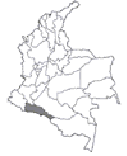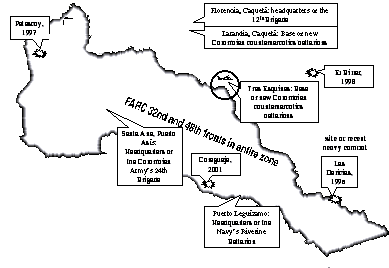"Why we oppose the Andean Regional Initiative," by the Center for Internaional Policy
1. It's still an overwhelmingly military plan.
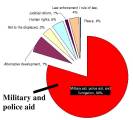 Last year's $1.3 billion « Plan Colombia » supplemental gave $860 million to Colombia for 2000 and 2001. Of that amount, 75 percent went to Colombia's military and police, with the remainder going to social and economic programs. This was hardly a « balanced package. »
Last year's $1.3 billion « Plan Colombia » supplemental gave $860 million to Colombia for 2000 and 2001. Of that amount, 75 percent went to Colombia's military and police, with the remainder going to social and economic programs. This was hardly a « balanced package. »
This year's plan looks more benign. The 2002 Foreign Operations request includes six other countries in the Andean region, and is now being called the « Andean Regional Initiative » (ARI) instead of Plan Colombia. The State Department is selling its $882 million ARI as a 50-50 balance between military and economic programs. The Colombia portion is 63 percent military.
- It is important to remember, however, that not all counter-drug military aid goes through the foreign operations appropriation. Much goes through Pentagon funding channels - channels which were included in last year's « Plan Colombia » supplemental, but don't appear in this year's request. Including DoD military aid shows that this is not a balanced package.
- Section 1004 of the 1991 National Defense Authorization Act, as amended, allows the Defense Department to provide counter-drug military and police assistance. While the amount of « Section 1004 » funding planned for 2002 is not available, an average of 1999 and 2000 would lead to an additional $107.18 million in military aid to the region:
(Millions of dollars)
Bolivia |
Brazil |
Colombia |
Ecuador |
Panama |
Peru |
Venezuela |
Total |
4.88 |
0.92 |
79.82
|
9.13 |
0.65 |
8.95 |
2.83 |
107.18 |
(Millions of dollars) |
Bolivia |
Brazil |
Colombia |
Ecuador |
Panama |
Peru |
Venezuela |
Total |
0 |
0 |
29 |
2 |
0.23 |
2 |
0 |
33.23 |
Adding these estimates for non-foreign operations aid channels means that: |
|
Colombia, 2002
|
2. Instead of reducing drug crops, it will only move them around.
As recently as the first half of the 1990s, not much coca was actually grown in Colombia. Coca itself was grown in Bolivia and Peru. This began to change in the mid-1990s, after the breakup of large drug cartels, interference with the « air bridge » between Peruvian and Bolivian coca sites and Colombian processing sites, and some successful alternative development programs. Though the net amount of coca cultivation in South America changed little, Colombia became the center of coca-growing.
The U.S. fumigations drastically reduced coca cultivations in Guaviare by the late 1990s. But the total amount of coca in Colombia more than doubled - and became centered in Putumayo department to the southwest, out of the range of the spray planes and deeper into guerilla territory. |
Coca cultivation in Colombia by department (hectares) | ||||||
Department |
1994 |
1995 |
1996 |
1997 |
1998 |
1999 |
Guaviare |
26,300 |
28,700 |
38,600 |
29,000 |
7,000 |
8,200 |
Putumayo |
5,000 |
6,600 |
7,000 |
19,000 |
30,100 |
56,800 |
Caquetá |
11,700 |
15,600 |
21,600 |
31,500 |
24,000 |
6,800 |
Bolívar |
2,000 |
3,500 |
6,500 |
|||
N. Santander |
7,000 |
7,800 |
||||
Other |
6,600 |
17,400 |
||||
Total |
45,000 |
50,900 |
67,200 |
79,500 |
78,200 |
103,500 |
|
Nothing in the current strategy guarantees that increased fumigation in Putumayo won't just move coca somewhere else. We've seen coca move from Bolivia and Peru to Guaviare to Putumayo. Continuing the same strategy will simply cause coca to pop up elsewhere. This is already happening. In March, immediately after the first fumigations in Putumayo, the New York Times reported of new coca cultivation in a department immediately to the west, Nariño, in an area the locals are calling « Little Putumayo. » According to the Times, the spraying in Putumayo « displaced coca growers and their crops, sending them to the jungles here in Nariño Province. It is a familiar pattern. » 3. It could fail militarily - and an escalation could come next.The strategy at the heart of the U.S. military package is centered on Colombia's department of Putumayo, along the border with Ecuador. Putumayo has been dominated by Colombia's FARC guerillas for over twenty years, and the FARC shoots back at drug-crop fumigation planes. The strategy has set up three battalions in Colombia's army, armed with dozens of helicopters. The battalions' mission, according to the U.S. Southern Command, is « setting the security conditions that are mandatory for safe and productive execution of eradication and other counterdrug operations » in Putumayo. Putumayo
But can « security conditions » be achieved by this plan? The strategy calls on 2,250 troops with a few months' training to force Colombia's FARC guerillas out of one of its most fiercely defended strongholds. Several battles in the past few years have demonstrated the guerillas' ability to launch large-scale military attacks in Putumayo. The Southern Command's Gen. Charles Wilhelm told a House committee in 2000, « We've received numerous reports that the insurgents have surface-to-air missiles. We've heard everything from U.S. Redeye missiles on up to SAM-16s from Eastern Europe. » What happens if our plans in Putumayo fail? What will the next step be? It is not too far-fetched to imagine that the debate over a 2003 aid package might take place after several pitched battles that may involve losses in Putumayo. There is some likelihood that we may be debating another escalation in our military involvement a year from now. While Vietnam analogies are not quite adequate, we must guard against « mission creep » and an uncomfortable level of military involvement in a country fighting one of the world's bloodiest conflicts. 4. It relies too heavily on unaccountable private contractors. |
|
At least six private U.S. corporations on State Department and Pentagon contracts and sub-contracts operate in Colombia. They perform services that include flying drug-crop fumigation aircraft, ferrying battalions into combat, serving as mechanics and logistics personnel, performing bottom-up reviews of the armed forces, and gathering aerial intelligence. The contractors operate with very little transparency or oversight, raising several important questions:
We can't even answer these questions because of the lack of transparency and accountability in which the contractors operate. Because these risks are so plausible and real, it is absolutely crucial that existing limits on contractors be maintained. |
As they operate without any accountability or oversight, civilian contractors in the Andes have been involved in some disturbing incidents:
|
5. It could bring increased human rights violations.The United Nations High Commissioner for Human Rights and other human rights groups have documented very close ties between the Colombian military and paramilitary groups in Colombia's Putumayo department, the zone where most U.S. military aid is being spent. Nothing is being done to break those ties. Will U.S. assistance inadvertently help the paramilitaries?
Paramilitaries have been on a rampage in Putumayo. Since they first appeared in the zone, the United Self-Defense Groups of Colombia have killed hundreds and displaced thousands. Their collaboration with military units in the area is disturbingly common. In October 2000, a bold police officer denounced military-paramilitary cooperation in Puerto Asís to local civilian authorities. According to the Bogotá daily El Tiempo, the policeman reported that the paramilitaries blatantly identify themselves with insignia and move easily in clearly marked vehicles. The policeman said he did not understand "the abilities and skills that they use to make a mockery of the Army's roadblocks, and to station themselves right in front of them." He added that he has heard numerous charges that the local army command meets regularly with paramilitary leaders. In August 2000, a BBC reporter showed how easily and openly the paramilitaries operate in Putumayo: I was looking to contact the paramilitaries who control the town [of Puerto Asis, Putumayo] and some of the neighbouring hamlets. ... Finding them was not as hard as I had thought. Despite the fact that the Colombian state denies there are any links between them and the right-wing death squads, their headquarters in Puerto Asis is five minutes drive past the local army base, in a luxurious villa. To get there I just hailed a taxi and asked the driver to take me to the paramilitary headquarters, as if I knew where it was and something I did every day of the week. He did not even blink, simply put the car in gear and sped down the potholed streets, passing the army checkpoint and into the countryside outside the town. The United States is pumping arms, helicopters, and well-trained military units into this zone of close military-paramilitary cooperation. It is not unreasonable to expect increased human rights violations to result. There is a danger that U.S.-provided intelligence, equipment and perhaps even weapons could find its way to the paramilitaries. This appears to have happened already with some U.S. aid in Putumayo, as the Boston Globe reported in March. On a recent day, one gunman, dressed in plain clothes and standing guard in a village, picked through a pack of US Army C-rations, hunting for chewing gum and pound cake. He shrugged off questions about where he got the supplies, issued to the three Colombian Army antidrug units that have been trained by US Special Forces advisers. 6. Our European allies do not support the policy.Except for Spain, not one of our European allies has endorsed Plan Colombia. Most see it as a big mistake, and many have expressed disappointment that they had no chance to take part in designing it. The European Parliament declared in February that « Plan Colombia contains aspects that run counter to the cooperation strategies and projects to which the EU has already committed itself and jeopardize its cooperation programs. » The U.S. and Colombian governments had hoped that non-U.S. donor countries would contribute $2 billion to Plan Colombia. After several donors' conferences, however, Europe has pledged only $350 million in assistance, which they insist is support for Colombia's peace process and not for Plan Colombia. (They also point out that the $350 million contribution is about equal to the United States' pledges of social and economic aid in 2000-2002.) « We are preparing a European Program of aid to the Peace Process in Colombia, which is totally different from Plan Colombia. » - Renaud Vignal, European Union, October 2000 |
Donor |
Millions of dollars |
|
Donations specifically for Plan Colombia: $1.8 billion | ||
United States |
Law, July 2000 |
860 |
United States |
Previously-planned aid, 2000-2001 |
330 |
United States |
Andean Initiative, Colombia portion |
508 |
Spain |
Madrid donors' conference, July 2000 |
100 |
Donations to the peace process and specifically not for Plan Colombia: $721 million | ||
United Nations |
Madrid conference, July 2000 |
131 |
Norway |
Madrid conference, July 2000 |
20 |
Europe |
Brussels conference, April 2001 |
355 |
Japan |
Brussels conference, April 2001 |
175 |
Canada |
Brussels conference, April 2001 |
40 |
What should we be doing instead?
|
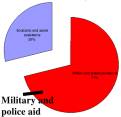
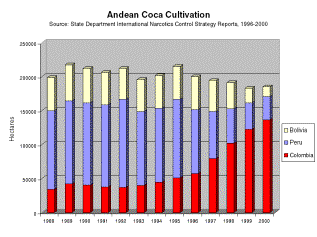 Even if U.S. plans in Putumayo are totally successful, there is no reason to believe that U.S. fumigations will do more than merely move drug crops somewhere else. There is plenty of room to move: Putumayo is the size of Maryland; the jungles east and south of Colombia's Andes are the size of California. Coca-growing can also move across Colombia's borders. All coca produced in South America in 2000 could fit in a square area 26.7 miles on one side (two-thirds the size of Rhode Island).
Even if U.S. plans in Putumayo are totally successful, there is no reason to believe that U.S. fumigations will do more than merely move drug crops somewhere else. There is plenty of room to move: Putumayo is the size of Maryland; the jungles east and south of Colombia's Andes are the size of California. Coca-growing can also move across Colombia's borders. All coca produced in South America in 2000 could fit in a square area 26.7 miles on one side (two-thirds the size of Rhode Island). Colombian coca was first centered around Guaviare department in south-central Colombia. The United States set up a large-scale fumigation program there in 1995 - but never offered affected peasants a cent of alternative- development aid.
Colombian coca was first centered around Guaviare department in south-central Colombia. The United States set up a large-scale fumigation program there in 1995 - but never offered affected peasants a cent of alternative- development aid.